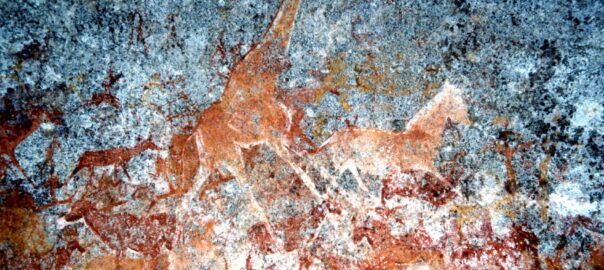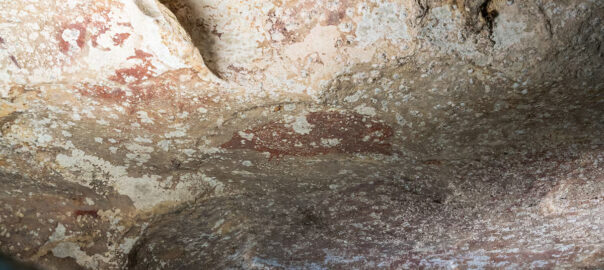
The First Stories
“The world we experience as ‘out there’ is actually a reconstruction of reality that is built inside our heads. It’s an act of creation by the storytelling brain.”
― Will Storr, The Science of Storytelling: Why Stories Make Us Human and How to Tell Them Better
Paleolithic people had stories to tell. From about 40,000 years ago, and for approximately the next 25,000 years — a period 12 times longer than the Common Era — they conveyed these through images painted on cave walls, carved on ivory tusks, engraved and etched on stones and shells, and did so, as far as we can tell, all over Europe, Asia and Siberia, and, to a lesser extent, Australia and Africa.
These images, whether depicted on rock surfaces or as three-dimensional figures, were almost certainly created by shaman – men and women who functioned as a channel of intercession between their community and the spirit world. As healers, diviners and savants, they would return from vision journeys not only with solutions and insights that would benefit individuals and the whole community, but with stories of their travels that would stimulate, heal and inspire group connection, cohesion, collaboration and purpose, and sometimes answer questions about the group’s origin and destiny.
We describe several sites in the Paleolithic section of this website and give ample evidence to show that behind the caves that held these images, and behind the images themselves, were stories.
Imagine the stories that accounted for the often almost inaccessible entrances to these ritual spaces, such as the one described in paleontologist Herbert Kühn’s book On the Track of Prehistoric Man.
Today, we know about sound waves, but back then echoes, reverberations and other auditory illusions may have inspired stories. As travelers, moving in small bands, approached a deeply hidden ritual site, imagine the tales they told each other to explain unfamiliar subterranean echoes (of clapping, stamping, drums and flutes) becoming louder and louder. Reflect on the fact that the 14,000-year-old image of “The Sorcerer” at Les Trois Frères, was deliberately created, “four meters above the floor in an apparently inaccessible position only to be reached by a secret corridor climbing upwards in a spiral,” and consider the impact and the story behind this enigmatic figure suspended above those who entered the space below. There would have been stories that explained natural events like earthquakes, meteor strikes, thunder and lightning; and stories relating to the power of the Sun, first harnessed to reflect the summer and winter solstices at Lascaux around 17,000 years ago.
As the scholar and Paleolithic archaeologist Alexander Marshak notes: “The storytelling skill, helped [Paleolithic man] to see and recognize process and change, to widen his references and comparisons, to ‘understand’ and to participate in them in storied terms, and it enabled him to tell and foretell them. One assumes, then, that the kind of stories a man tells . . . helps him to unify the extraordinary diverse phenomena and processes of his life; and since a story is an equation, a cognitive form for abstractly structuring and dealing with process and relation, the uses and complexities of the story form would change as the culture became more complex.”
Above Ground and Below: The ubiquitous structure of our first stories
As religious historian Geoffrey Parrinder said of the myth, “its inner truth was realized when the participant was transported into the realm of the sacred and eternal.” For the ancients, this transcendent capacity was perhaps more evident, since there was no division between the supernatural and natural – the supernatural was natural.
The structure of the cave: its arched roof, narrow passageways and deep caverns below were part of, and built into, Paleolithic people’s idea of, and belief in, a three-tiered cosmos. Unsurprisingly, given the length of human pre-history, this neurological underpinning is common to all human beings, so the interpretation of it is consistent: Along with our normal, everyday world, a dangerous Underworld and a limitless, light-filled, “heavenly” Overworld are envisaged in almost all cultures, from Paleolithic times to today.
Throughout the continents of America, Africa and Australia, as well as in Siberia and Central Asia, shamanic vision journeys tell of entering an underworld or experiencing supernatural flight to a spirit world above. The Tungus shamans of Central Asia descend to the underworld through a narrow hole to cross three streams, where they encounter the spirits. The South American Tapirap shamans change into birds and fly through the cosmos; the North American Inuit shamans transform from humans into birds and then fly. The shamans of Panama’s Cuna tribe send spirits back into the sky. The San of southern Africa believe in a world above, where the spirits reside, and another world underground or underwater, which is below our everyday world.
It meant that, once inside a cave, Paleolithic people would have experienced a profound and immediate connection with the spirit worlds above and below. The overall effect created was of a multi-sensory experience: “Through dancing, music, imitation of animal sounds and dramatic revelation of already existing paintings, vision seekers stocked their minds with emotionally highly charged mental images. The caves were alive with the sounds and visions of potent spirit animals,” say anthropologists, Lewis-Williams and David Pearce. Behind it all were the tales, memories and myths that inspired the images and motivated the group.
Many of our contemporary places of worship, with their domed ceilings and underground crypts, reflect the spaces within which humanity took the first steps in its search for a deeper understanding. This same cognitive pattern is evident in thousands of our stories — whether in Greek myths, in Christian prayers, in how the experiences of prophets and saints are described, and in the adventures of our modern popular heroes. The religious historian Mircea Eliade observed this and concluded that “probably a large number of epic ‘subjects’ or motifs, as well as many characters, images, and clichés of epic literature, are, finally, of ecstatic origin, in the sense that they were borrowed from the narratives of shamans describing their journeys and adventures in the superhuman worlds.”
Recall that in Exodus – a word which, incidentally, is from the Greek Exodos, which literally means “the road out” (3:10) – Moses is sent by God on High to liberate the captured Israelites from Egypt and lead them out of enslavement to a promised land, “flowing with milk and honey”; he later had to go way up and then come way down from Mount Nebo on the top of Pisgah to present the Ten Commandments. The Articles of Religion for today’s Methodist and Protestant Churches — that’s an estimated 880 million adherents worldwide — reflect this same cognitive structure; they state that “Christ did truly rise again from death, and took again his body, with flesh, bones, and all things appertaining to the perfection of Man’s nature; wherewith he ascended into Heaven, and there sitteth, until he return to judge all Men at the last day.”
Stories Move Out of the Caves
The change in climate at the end of the Ice Age ushered in the Neolithic (New Stone) Era. As we describe in this section of the website, warmer weather meant that food supplies increased and populations grew, such that some form of hierarchy was perhaps inevitable. Shamans remained the key storytellers, though a shaman’s position altered from that of a specialist facilitator who was part of an egalitarian group, to a more prestigious priestlike role, with control over the group’s experiences, beliefs and worldview. The problems changed, so the stories that explained them and embedded their solutions had to change too.
The shaman and elite chiefs were faced with a threefold problem that went something like this: how do we placate and honor the spirit world in this new and vast environment – after all, we don’t want a return to the Ice Age! And how do we avoid anarchic rebellions between individuals and groups now that the population has exponentially increased? And, most importantly, how do we maintain and secure our own position in society? Their insightful solution involved at least two stories: the first would emphasize the importance of the dead — as we know from early burial sites, people were already emotionally attached to those who had died and were concerned about the afterlife. The second would ensure that everyone unequivocally knew that their religious obligation was to participate in the construction of monumental stone structures within which the community, under the direction of shaman-priests and elite chiefs, would honor and connect with the dead and the spirit world. Thus, the behavior of thousands was controlled. As the archeologist Professor Michael Parker Pearson pointed out when talking about Stonehenge, building these monumental structures required everyone “to pull together” in “an act of unification.” “It’s the labor that counts” says Pearson. “We are looking at an age when devotion was really important. This is just one of a whole series of spectacular earth-moving and stone-moving events that Neolithic people were not just capable of, they wanted to do it. I think that is the missing part of the equation: that is, if you have the will, you can move mountains. And they clearly did.”
Behind all their effort were stories that propelled, motivated, and inspired this amazing period. We know this because these early farmers left a trail of monolithic structures in their wake, from the 11,000-year-old “first” temple, Göbekli Tepe, in southeastern Turkey, to Stonehenge in Britain, which was finally completed about 4,500 years ago. Stories were carved on these giant megalithic structures, on the pillars of Göbekli Tepe and Nevali Çori, or represented in the looming bulls’ heads protruding out of the domicile walls at Çatalhöyük — and carried on from there. Images were transported along with their stories and the beliefs they enshrined. Symbols such as spirals — thought to represent the trance state — travelled to Malta and to the passage tombs of Gavrinis in France, Newgrange in Ireland and beyond.
Archeologist Trevor Watkins of the University of Edinburgh writes:
“The great advantage of all this symbolic reference through physical artefacts was that, unlike speech, dance or ritual enactment, which is transient, the physical symbolism with which they surrounded themselves was always there, always reminding them, teaching their children. They had learned what the psychologist Merlin Donald (1991, 1998) has called ‘external symbolic storage’ …Above all, these ideas about their world were systematic, categorical, discriminating, ordered. Such a systematic and symbolically rich world-view was ideal for providing the cultural underpinning that could be shared by all those in the community, for they lived in and by and through the symbolic references in their settlements. And finally, such a systematic and readily symbolised world-view was infectious, readily communicated and easily learned by others who had the same cognitive skills and the same need to cope with their new way of life.”
We can only wonder at the stories that stimulated and maintained such devotion over more than 6,000 years and over such vast distances.
The age of massive stone monuments would eventually come to an end with the advent of metallurgy. Metal would make people think about new ways of interpreting the same age-old questions – who are we and where are we going? Stories would be modified accordingly.
External Stories and Videos

51,000-year-old cave painting may be earliest scene depicted through art
Frances Vinall, Washington Post
The artwork, an example of early storytelling, shows three humanoid figures and a pig. Sulawesi residents of that era (in what is now Indonesia) were “besotted” with painting pigs, an expert said.
